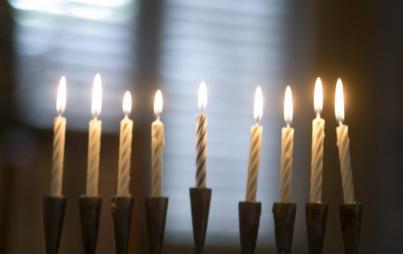
'Tis the season for complex feelings about our bodies as the diet industrial complex celebrates the leadup to its busiest season.
Before continuing this admittedly kinda-bummer essay where I essentially read Christmas, I have to say as a disclaimer that I really like warm sweaters and the seasonal Jack Daniels apple cider whiskey and watching Scrooged on repeat and fireplaces and my snowflake screensaver. I just don't understand why all those amazing things have to come with a side of fat shaming and nuclear family propaganda, ya know? Like, you don't get to hand me a steamy cup of buttered rum and then tell me I also have to uncritically celebrate capitalist heteropartriarchy, America. Like, that's called a bait and switch.
It occurred to me that it was no coincidence that one of the peak moments of culture-wide fatphobia coincides with the holidays. The holidays affirm our culture and its values. The unfortunate truth is that punishing and alienating non-conforming and marginalized people is as significant of an American value as gathering around the Christmas tree.
I wanted to examine the history of Christmas in the United States and its connections to several types of marginalization, including fatphobia. I prioritize fatphobia because that's my area of expertise, but push the reader to see my analysis on class, family, and capitalism as completely connected to discrimination based on body size.
Ready?
This season begins as a slow autumnal descent into aspirational family propaganda in late October into the icy height of fat shaming on January 1.
The romantic, wintery language and imagery around the (mostly) white, straight and - yes - thin nuclear family acts as a kind of smoke screen that veils the undeniably heirarchical and unjust reality of family values in this country.
For those of us who cannot or do not wish to recreate nuclear family structures, the holidays can feel especially isolating. In many ways, this season rewards those who have successfully heeded our culture's call to conform to certain core values - among them thinness, capitalism, heterosexual marriage and child-bearing, the accumulation of wealth and the exchange of commodities meant to symbolize a universal goodwill that has no basis in the facts of American history.
And that's the crux of this: the holidays (as we now know them) serve a valuable cultural function: to reward those who adhere to American values.
It's no accident that fatphobia and the holidays go together like reindeer shaped cookies (yum!) and milk.
I looked to the writing of Penne Restad, Distinguished Senior Lecturer in American History at the University of Texas, Austin and the author of Christmas in America: A History (https://www.amazon.com/
She writes about the connections between Christmas and ideas of family and society:
"Charity functioned... as a symbolic, cathartic exercise in selflessness. The same social changes that fostered gift-giving as a means of reinforcing familial and social attachments at the private level also inspired charitable gifts as a way of declaring, if only symbolically, a unity and safety in society that extended even to the most impoverished."
Restad is talking about the way that Christmas gift-giving serves two symbolic functions: gifts given to family solidify the importance of blood relation and the privatized sense of obligation and responsibility that is central to the nuclear family. Gifts given to the poor act as a way of performing a small act of charity in lieu of centering equity for all people all year round; she calls out this charity as largely self-serving and designed to be "cathartic" for the individual gift giver.
She continues:
"In this glow of self-congratulation, Americans persisted in seeing poor relief as a matter of individual action to be undertaken on much the same terms as gift-giving within the circle of family... The deserving poor, as the outermost members of the larger community, received gifts too, though often the least valuable and certainly the least personal of all."
These seasonal acts of charity reinforce the idea that poverty (and, by extension, other social problems) can also be dealt with privately, i.e. on an individual rather than cultural level. When we extend this part of her analysis to the understanding of fatphobia, we see that it's treated the same way. Fatphobia is actually a social problem that needs to be stopped through large-scale societal and legislative means, but instead it's viewed as an individual problem that needs to be solved by fat people becoming thin people.
She goes on to write:
"In their comprehension of poverty and its solutions, most Americans moved little beyond Ebenezer Scrooge's personally fulfilling but ultimately narrow patronage. Their sentimentalization of 'worthy paupers' at Christmas time, especially virtuous but destitute women and vagabond children, did not question the essential goodness of the market economy that had, directly and indirectly, produced the poverty."
Here she talks about all the small things we do to fix the problems of capitalism in ways that only reinforce it (kind of like when you buy a shirt that says "end overseas worker exploitation" that was made by an exploited overseas worker). She also talks about the myth of the worthy and unworthy poor, which is also mirrored in the Good Fatty vs. Bad Fatty dichotomy. The "worthy" marginalized person is one who accepts the role that society has carved out for them. This includes accepting blame for their condition and performing shame or inferiority through language and behavior. For instance, a "worthy" marginalized person may apologize frequently for having needs or may offer vulnerable information about how it's their fault they became "this way" (I remember once a fat woman introduced herself by stating her name and telling me she that before she had a skiing accident she was a size zero).
Restad further points out the way that helping the deserving poor takes on special sentimental meaning during Christmas, suggesting that the behavior provides more pleasure for the giver than it does relief for the recipient.
Finally, the tradition of giving gifts made with unethical or questionable labor practices has a long history in the US. Restad writes:
"A work force of skilled and reliable elf-labour helped secure Santa's place in the pantheon of American business. These North pole elves were not unlike immigrants working in the nation's sweatshops. Unassimilated, isolated from the rest of society, and undifferentiated by individual name or character, the best of them worked hard, long and unselfishly. Their existence made manifest a maxim that hard work and a cheerful attitude benefited all."
This section of the book is important because she talks about the invisibility of the marginalized people who made (and make) Christmas joy possible. And how exploitation is transformed into cheer through the sheer commitment to a self-serving mythology. In addition to the huge population of exploited workers both overseas and in America's prisons, I see fat people - as well as other marginalized communities - playing an integral role in maintaining this cultural celebration. For instance, many fat people act as the underpaid help and caretakers during holiday gatherings while being denied access to fair pay. We blame ourselves for these conditions.
Examining what is at the core of one of our nation's biggest cultural moments teaches us about what and who is valued. Christmas is a time that encourages us to dig our heels in and get comfortable with the idea that everything is ok as long as there are presents under our tree and toys in our stockings. I think if 2018 has taught us anything it's that we can't afford to keep napping by the fireplace while the world burns in a massive trash fire.
I want to end by saying that if you're feeling the squeeze of the unique holiday brand of fat hatred, please know you're not alone. And please know that it's not by accident that this is the time of year when many of us feel insufficient - it's by design.








